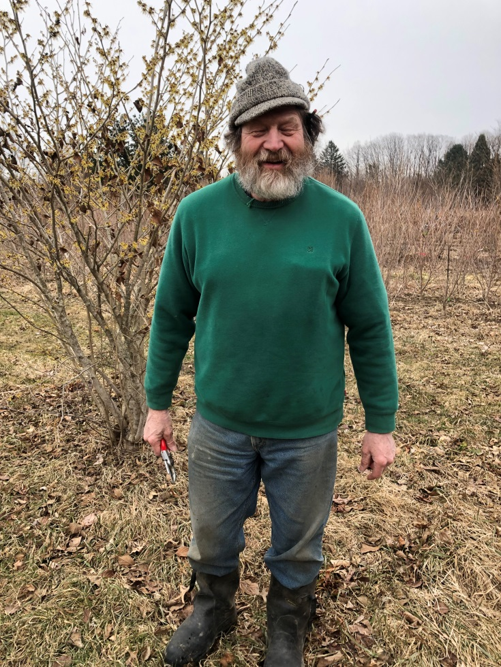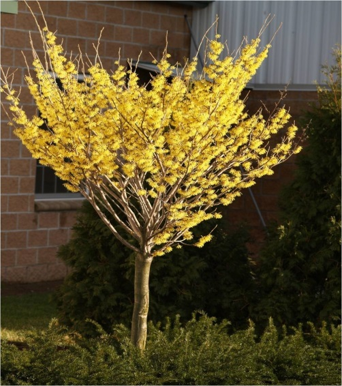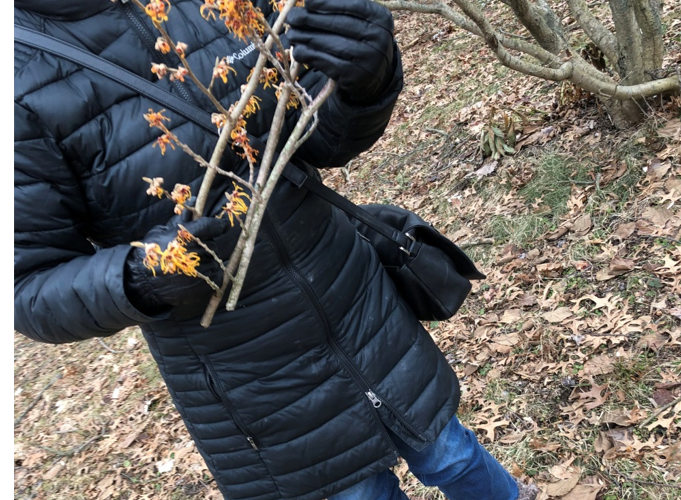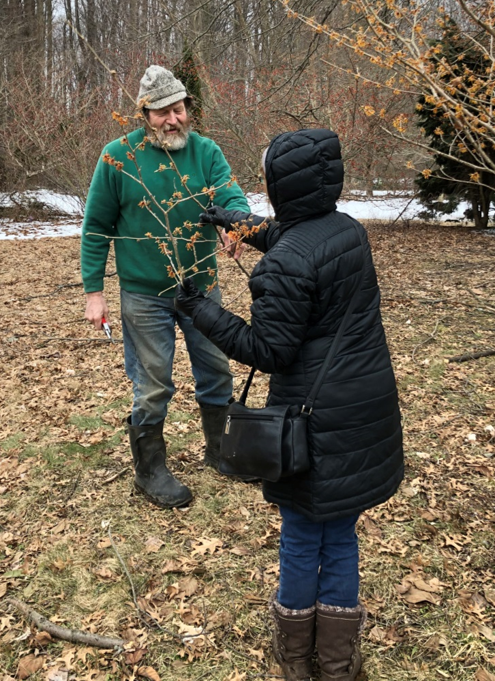by Mark Gilson
Witch hazels arrive early to garden parties in the Midwest, too early for some gardeners! Put on your winter coat and muck-boots to catch their colorful shout-out, mostly in early March, before the forsythias and hellebores! Although their early-spring blooms may be inconvenient for the faint of heart, they are delightful, fragrant, fascinating and well worth the trip outside!
How does a winter flowering shrub become pollinated? Actually, this occurs through the efforts of a ‘shivering moth’ that makes its rounds on cold nights. Earnest palpitations raise the moth’s internal temperature by as much as fifty degrees!
We are lucky to have a plantsman and wholesale nurseryman in Madison, Ohio, who makes it his business to collect and grow these under-appreciated shrubs: Tim Brotzman, Brotzman’s Nursery. Tim invited us to his nursery on a cold muddy Saturday in early March 2019, a perfect day to witness this private pageant! At the beginning of the long spruce-draped drive leading to the house that Tim built with his father, we find two bright yellow sentinels, Hamamaelis xintermedia palida. My wife and I were unescorted at this point and thankful for the labels! Each blossom on a Witch hazel is remarkable, only an inch or two wide, tiny colorful streamers exploding like party-poppers from tight centers all along the woody stems. Flowers may accompany dried fruit capsules that popped the seeds up to thirty feet in the previous fall. Tim says horticulture makes us better observers. As we catch up with him and hike through the orderly fields, he introduces each new plant, witch hazels and other friends, as treasured personal companions, with stories of their idiosyncrasies, temperament and original collection. For an hour, we were fortunate to be the ‘shivering moths’ visiting each plant in the collection.

Tim began his horticultural education working for his father, Charlie, a renowned nurseryman, story-teller and poet. After earning a degree from The Ohio State University in the early 1970s during the golden age of OSU Horticulture, Tim studied in England and Germany. He worked with David Leitch, local world-famous hybridizer of rhododendrons, as well as distinguished plantsman at The Holden Arboretum and local nurseries. Somewhere along the way, he traveled to Tibet on a plant-gathering expedition. Among the legendary International Plant Propagators Association, Tim is recognized as a ‘fellow’ for his years of attendance and service. The best thing about Tim is that for those with any connection to horticulture, he celebrates and extracts any knowledge and experience, no matter how limited! Talking with Tim, whether a plantsman, local grower or master gardener, you are elevated to a revered place in a fundamentally important industry and pastime.
The fall-blooming Hamamaelis virginiana is native to the Eastern and Southern US. Find it in shady woods on your autumn hikes, sometimes clinging to the side of woodland ravines. Native Americans utilized it for treatment of various inflammations and tumors. A derivative is used in Witchazel’s Oil. Hamamelis Mollis is more common in the nursery trade than the native fall-blooming form, although that is changing with renewed interest in native plants. H. Mollis was crossed with H. japonica to form many cultivars of H. xintermedia common to the trade. Red-flowering varieties were selected by early developers, including Hamamelis xintermedia ‘Diane, ‘Livea’, and ‘Jelena’, all of which Tim pointed out. ‘Arnold’s Promise,’ brilliant yellow, remains one of the popular cultivars (although Tim discounts any connection to the body builder and former governor of California!). Other varieties include ‘Glowing Embers,’ ‘Strawberries and Cream,’ and ‘Orange Peel.’ There are also vernalis types, including H. v. ‘Kohankie Red.’

(Photo by OSU-Extension Lake.)
Tim shares detailed origination data on all his plants, including one he collected from within an armored gunnery live-fire range in Louisiana (Tim’s friend, Tony Debevc, Debonne Vineyards, flew him there in his own plane). As we walk among the rows, Tim trims flowering branches with his well-used Felco clippers for us to enjoy in our home. We comment on the odors of each, from cinnamon to apple to a pleasing but obscure vernal scent. As so many plants in our gardens are bred these days for color and other characteristics, it’s great to put our noses to work again!

Recent cold winters were hard on the Witch Hazels. One year the local temperatures dropped to 30 below zero, followed by a wet year, followed by a March with a precipitous drop to minus eight degrees. Some of the casualties remain evident in the field. Others returned to life amidst a bundle of low stems. Each cultivar seems to require its own regimen, some seed-grown, most grafted. We wonder how all this hard-won knowledge will be transferred on. Tim is no longer a young man, despite his customary energy, wit and positive engagement. Documentation of our horticultural experiences remains a challenge for our entire industry!
Other gardening treasures abound along the edges of the Witch hazel trials…columnar white pine…a beech seedling from China that has proven unsusceptible, so far, to the mysterious ‘beech blight’… unusual pines…dogwoods…many one-of-a-kind specimens.

As a businessman, Tim is consumed with inventory matters, how to record, promote and price the myriad wholesale stock in his fields. We value the time he took from his busy day to provide these precious moments…always too few in the day-to-day chaos of our chosen fields…for horticultural observation, appreciation and instruction!